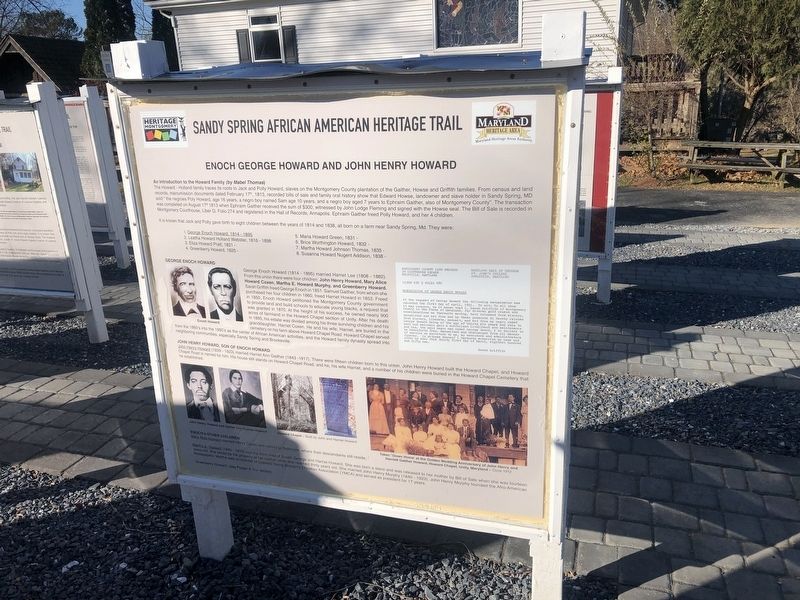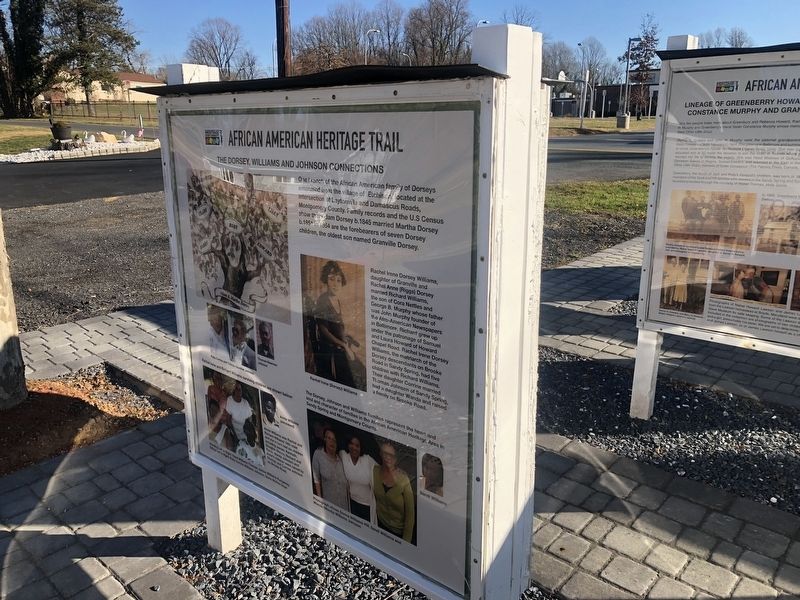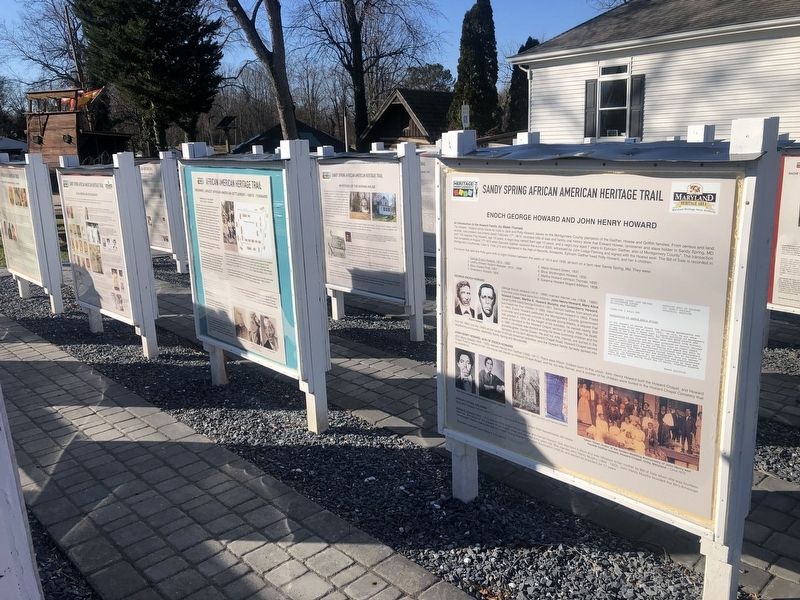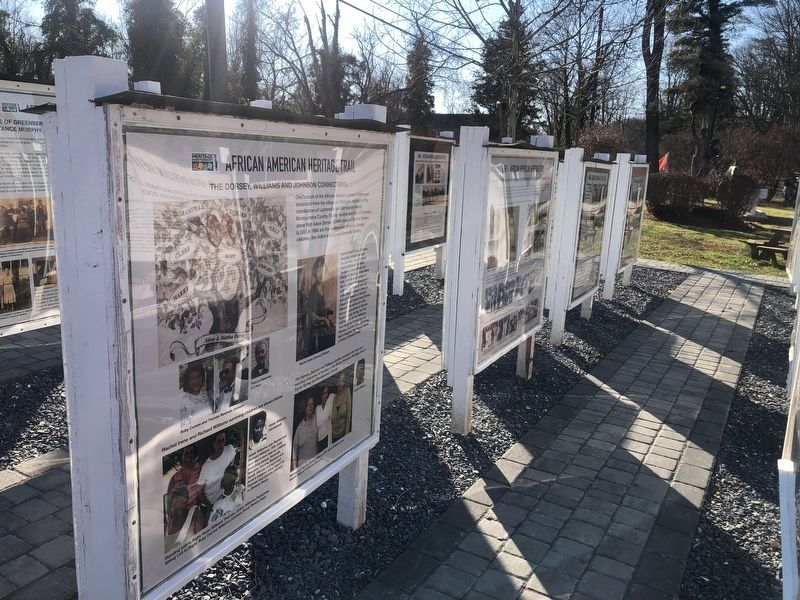Sandy Spring in Montgomery County, Maryland — The American Northeast (Mid-Atlantic)
Enoch George Howard and John Henry Howard / The Dorsey, Williams and Johnson Connections
Sandy Spring African American Heritage Trail
— [Sandy Spring Slave Museum & African Art Gallery] —

Photographed By Devry Becker Jones (CC0), December 12, 2021
1. Enoch George Howard and John Henry Howard side of the marker
Enoch George Howard and John Henry Howard
An introduction to the Howard Family (by Mabel Thomas)
The Howard - Holland family traces its roots to Jack and Polly Howard, slaves on the Montgomery County plantation of the Gaither, Howse and Griffith families. From census and land records, manumission documents dated February 17th, 1813, recorded bills of sale and family oral history show that Edward Howse, landowner and lave holder in Sandy Spring, MD sold "the negroes Poly Howard, age 16 years, a negro boy named Sam age 10 years, and a negro boy aged 7 years to Ephraim Gaither, also of Montgomery County". The transaction was completed on August 17th 1813 when Ephraim Gaither received the sum of $300, witnessed by John Lodge Fleming and signed with the Howse seal. The Bill of Sale is recorded in Montgomery Courthouse, Liber Q. Folio 274 and registered in the Hall of Records, Annapolis. Ephraim Gaither freed Polly Howard and her 4 children.
It is known that Jack and Polly gave birth to eight children between the years of 1814 and 1838, all born on a farm near Sandy Spring, Md. They were:
1. George Enoch Howard, 1814 - 1895
2. Leatha Howard Holland Webster, 1816 - 1898
3. Eliza Howard Pratt, 1821 -
4. Greenberry Howard, 1825 -
5. Maria Howard Green, 1831 -
6. Brice Worthington Howard, 1832 -
7. Martha Howard Johnson Thomas, 1835 -
8. Susanna Howard Nugent Addison, 1838 -
George Enoch Howard
George Enoch Howard (1814 - 1895) married Harriet Lee (1808 - 1882). From this union there were four children: John Henry Howard, Mary Alice Howard Coxen, Martha E. Howard Murphy, and Greenberry Howard. Sarah Griffith freed George Enoch in 1851. Samuel Gaither, from whom she purchased her four children in 1860, freed Harriet Howard in 1853. Freed in 1850, Enoch Howard petitioned the Montgomery County government to provide land and build schools to educate young blacks, a request that was granted in 1870. At the height of his success, he owned nearly 900 acres of farmland in the Howard Chapel section of Unity. After his death in 1895, his estate was divided among his three surviving children and his granddaughter, Harriet Coxen. He and his wife, Harriet, are buried in the cemetery on his farm above Howard Chapel Road. Howard Chapel served from the 1860's into the 1950's as the center of African American activities, and the Howard family dynasty spread into neighboring communities, especially Sandy Spring and Brookeville.
John Henry Howard, Son of Enoch Howard
John Henry Howard (1839 - 1923) married Harriet Ann Gaither (1843 - 1917). There were fifteen

Photographed By Devry Becker Jones (CC0), December 12, 2021
2. The Dorsey, Williams and Johnson Connections side of the marker
Enoch's Other Children
Mary Alice Howard married Henry Coxen and moved to Baltimore, where their descendants still reside.
Martha E. Howard (1846 - 1915) was the third child of Enoch George and Harriet Howard. She was born a slave and was released to her mother by Bill of Sale when she was fourteen years old. She would be the property of her mother when she reached thirty years old. She married John Henry Murphy (1840 - 1923). John Henry Murphy founded the Afro-American Newspapers. Martha was a co-founder of the Colored Young Women's Christian Association (YMCA) and served as president for 17 years.
Greenberry Howard. (see Poster # For details)
The Dorsey, Williams and Johnson Connections
One branch of the African American family of Dorseys emanated from the village Etchison, located at the intersection of Laytonville and Damascus Roads, Montgomery County. Family records and the U.S. Census show that Adam Dorsey b. 1845 married Martha Dorsey b. 1851 in 1864 and are the forebearers of seven Dorsey children,

Photographed By Devry Becker Jones (CC0), December 12, 2021
3. Enoch George Howard and John Henry Howard side of the marker
Rachel Irene Dorsey Williams, daughter of Granville and Rachel Anne (Riggs) Dorsey married Richard Williams, the son of Cora Nettles and George B. Murphy whose father was John Murphy founder of the Afro-American Newspaper in Baltimore, Richard grew up under the patronage of Samuel and Laura Howard of Howard Chapel Road. Rachel Irene Dorsey Williams, the matriarch of the Dorsey descendents on Brooke Road in Sandy Spring, had five children with Richard Williams. Their daughter Corrine married Thomas Johnson of Sandy Spring, had a daughter Wanda and raised a family on Brooke Road.
Rachel Irene and Richard Williams surviving children are shown below:
Annie Williams was Rachel and Richard Williams' fifth child and she in turn had six children including James, Kenneth, Douglas, Donna, Richard and Sandi, Wanda Johnson and Anne's children were raised by Thomas and Corrine Johnson on Brooke Road.
Erected by Sandy Spring Slave Museum & African Art Gallery.
Topics. This historical marker is listed in these topic lists: African Americans • Churches & Religion • Settlements & Settlers. A significant historical date for this entry is February 17, 1813.
Location. 39° 9.578′ N, 77° 1.971′ W. Marker is in Sandy Spring, Maryland

Photographed By Devry Becker Jones (CC0), December 12, 2021
4. The Dorsey, Williams and Johnson Connections side of the marker
Other nearby markers. At least 8 other markers are within walking distance of this marker. The Williams and Claggett Families in Ashton / Lineage of Greenberry Howard Family (here, next to this marker); Warrick Hill / Cornelius Awkard, Tolbert Awkard and Offords / James Offord (here, next to this marker); Cincinnati, Largest African American Settlement / Journey from Alloway to Sandy Spring (here, next to this marker); Charles Gilbert Thomas, Sr. / William and Evan Budd Homestead / Sandy Spring School / Ross J. Boddy (here, next to this marker); Brookeville - Mt. Zion / Early Builders in Sandy Spring: The Robert Hill Story (here, next to this marker); Ross J. Boddy / Archie (Jerry) Bell / Hill Top Elementary School (here, next to this marker); The Powell-Matthews-Cook and Brooks Families in Sandy Spring / Spencerville (here, next to this marker); Sadie Matthews Budd and Family / The Bowens, Mitchells and Jacksons of Ashton and Baltimore, MD (here, next to this marker). Touch for a list and map of all markers in Sandy Spring.
Credits. This page was last revised on January 24, 2022. It was originally submitted on December 14, 2021, by Devry Becker Jones of Washington, District of Columbia. This page has been viewed 1,092 times since then and 211 times this year. Photos: 1, 2, 3, 4. submitted on December 14, 2021, by Devry Becker Jones of Washington, District of Columbia.